|
|
|
Sort Order |
|
|
|
Items / Page
|
|
|
|
|
|
|
| Srl | Item |
| 1 |
ID:
179811


|
|
|
|
|
| Summary/Abstract |
One of President Joseph Biden's foreign policy priorities is to ‘renew’ and ‘strengthen’ the United States' alliances, as they were perceived to have been ‘undermined’ during the Trump administration, which regularly expressed concern that allies were free-riding on the United States' military capability. Yet the broad range of threats states face in the contemporary context suggests that security assistance from allies no longer only—or even primarily—comes in the form of military capability. We consider whether there is a need to rethink understandings of how alliance relationships are managed, particularly how the goals—or strategic burdens—of alliances are understood, how allies contribute to those burdens, and how influence is exercised within alliances. We do this by analysing how the United States–Australia and Australia–New Zealand alliances operate in the Pacific islands. Our focus on the Pacific islands reflects the United States' perception that the region plays a ‘critical’ role in helping to ‘preserve a free and open Indo-Pacific region’. We conclude that these understandings need to be rethought, particularly in the Pacific islands, where meeting non-traditional security challenges such as economic, social and environmental issues, is important to advancing the United States, Australia and New Zealand's shared strategic goal of remaining the region's primary security partners and ensuring that no power hostile to their interests establishes a strategic foothold.
|
|
|
|
|
|
|
|
|
|
|
|
|
|
|
|
| 2 |
ID:
016371
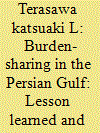

|
|
|
|
|
| Publication |
Aug 1993.
|
| Description |
171-195
|
|
|
|
|
|
|
|
|
|
|
|
|
|
|
|
| 3 |
ID:
136074


|
|
|
|
|
| Summary/Abstract |
“Smart Defense” is NATO's new approach to risk- and burden-sharing, which has been a chronic problem within the alliance since the 1950s. Numerous solutions have been proposed, but initiatives resulting in more equitable burden-sharing have never been fully implemented. There are two driving forces influencing a county's willingness to support such initiatives – the economic theory of alliances and the risks posed by the implementation of capability sharing. The authors examine each of these and propose that rather than aiming for group consensus on the production of capabilities, NATO should focus on interoperability through support functions. This approach provides the most likely solution for connecting the forces, doctrine, procedures, standards and other factors of joint capability production such that country leaders find the risks of doing so to be politically and militarily acceptable.
|
|
|
|
|
|
|
|
|
|
|
|
|
|
|
|
| 4 |
ID:
124412
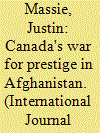

|
|
|
|
|
| Publication |
2013.
|
| Summary/Abstract |
This article provides a comprehensive assessment of Canada's prolonged and sizable military engagement in the war in Afghanistan in light of confounding expectations set by realism. It argues, from the perspective of neoclassical realism, that United States unipolarity, domestic elite consensus on an Atlanticist security policy, and executive autonomy vis-à-vis public dissent best account for Canada's evolving Afghanistan policy. These necessary conditions can be generalized to apply to past and future allied coalitions of the willing to help make sense of Canada's alliance burden-sharing.
|
|
|
|
|
|
|
|
|
|
|
|
|
|
|
|
| 5 |
ID:
178655
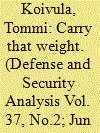

|
|
|
|
|
| Summary/Abstract |
This article proposes Stephen Jay Gould’s concepts of time’s arrow and time’s cycle as a conceptual tool to analyse NATO’s burden-sharing disputes. It argues that the controversies on burden-sharing in NATO can be assessed in terms of their cyclic or arrow kind nature, rendering some disputes more likely to recur than others and providing different kinds of starting points for their forecasting. The study identifies four cyclic categories in which burden-sharing has transformed into a political debate among NATO members during the post-Cold War era: geopolitical change related to Russia; periods of US foreign political retrenchment or renewal; the passivity or activism of European NATO members; and during NATO or allied out-of-area operations. Moreover, the study suggests an arrow kind of direction in burden-sharing disputes, indicating an expansion of disputes to cover comprehensive security, resilience, security co-operation and diplomacy, and to engulf also NATO partner countries.
|
|
|
|
|
|
|
|
|
|
|
|
|
|
|
|
| 6 |
ID:
124413
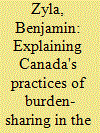

|
|
|
|
|
| Publication |
2013.
|
| Summary/Abstract |
While Canadian burden-sharing practices within NATO in the 1990s are well documented, the data in the literature raise two central questions: (1) was the practice of Canadian burden-sharing a one-time event, or was it part of a larger pattern of practices? and (2) what factors motivated Canada to shoulder the burden to the extent that it did? This article studies the extent of Canada's burden-sharing practices in the context of the International Security Assistance Force (ISAF) mission in Afghanistan. The article makes two arguments: first, Canada's commitment to NATO continued to be strong post-9/11; second, Canada's practices of sharing Atlantic burdens can be explained by its adherence to the norm of "external responsibility," which guided its foreign policy by appealing to Canada's humanitarian responsibilities to contribute at an extraordinary level to the promotion and maintenance of international peace and security.
|
|
|
|
|
|
|
|
|
|
|
|
|
|
|
|
| 7 |
ID:
162502
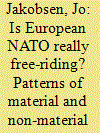

|
|
|
|
|
| Summary/Abstract |
Does European NATO free-ride on America? This article uses a mixed-methods approach to explore developments after the Cold War. I investigate both “material” measures, such as military expenditure and troop numbers, and a “non-material” indicator that draws on survey data of the public’s willingness to fight for their country. Results and conclusions are not univocal. On the one hand, European NATO members have generally reduced their military spending (relative to GDP), abolished conscription and downsized their military forces. Their citizens’ self-reported willingness to fight has also been quite low after the Cold War, in particular in states that host US military bases. On the other hand, some of these developments can surely be explained by a decrease in threat perceptions in Europe. Trends changed markedly after Russia’s 2014 annexation of Crimea, which moved many allies – in particular new NATO member states – to increase their defence efforts.
|
|
|
|
|
|
|
|
|
|
|
|
|
|
|
|
| 8 |
ID:
154731
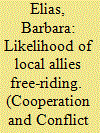

|
|
|
|
|
| Summary/Abstract |
In counterinsurgency interventions, free-riding by small, local allies is persistent. Yet, the literature on free-riding by small allies is largely limited to conventional multilateral partnerships, such as the North Atlantic Treaty Organization, neglecting other types of asymmetric alliances. Using new data containing 144 US requests to local allies in Vietnam, Iraq and Afghanistan, this article tests the logic of economic theories of alliances in counterinsurgency interventions. I find even when small allies are explicitly asked to contribute to alliance-wide security goods, they are likely to free-ride almost half the time (45%), and the likelihood of free-riding is dependent on whether local allies can be excluded by larger allies. This conclusion upholds the logic of economic models, since shared defense goods that exclude local allies fail to meet the criteria of public goods.
|
|
|
|
|
|
|
|
|
|
|
|
|
|
|
|
| 9 |
ID:
153457
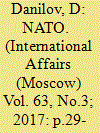

|
|
|
|
|
| Summary/Abstract |
PRESIDENT OF THE UNITED STATES Donald Trump called NATO an obsolete organization and demanded that the European allies should contribute bigger "fair shares" to European security. This includes, among other things, total fulfillment of their obligation to steadily raise their share of military expenditures up to 2% of their GDPs. This caused consternation among the European leaders and the fears that America's role and guarantees would be eroded, transatlantic unity weakened and the role of NATO undermined. Trump's unconditional acceptance of Brexit as the Brits' wise move fanned doubts in the new American administration's wholehearted devotion to the strategic alliance with Europe/EC and its ability to remain NATO's responsible leader.
|
|
|
|
|
|
|
|
|
|
|
|
|
|
|
|
| 10 |
ID:
186542
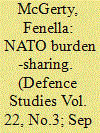

|
|
|
|
|
| Summary/Abstract |
How can NATO upgrade its understanding of (and metrics for) fair burden-sharing? Alliance burden-sharing is a lasting concern for the North Atlantic Treaty Organization (NATO) and will remain a focal point of the NATO 2022 Strategic Concept. Public discussions of NATO burden-sharing and the 2014 Defense Investment Pledge overemphasize defense expenditure and fail to account for alternative frameworks for understanding alliance burden-sharing and specifically, NATO’s optimal burden-share distribution. The U.S. Military Academy’s February 2022 NATO Strategic Concept Seminar featured a panel on burden-sharing frameworks and metrics. In this article, we present the main ideas and arguments, placed within the existing literature on alliance burden-sharing. We argue that, in the long-run, NATO can develop more fair, effective, and efficient burden-sharing arrangements by encouraging weapons and capability specialization, increasing inexpensive but influential operations such as advisory missions, and adapting flexible command and control structures when partnering with non-NATO actors on future battlefields. We argue that, in the short-run, NATO can refine the Defense Investment Pledge with a balanced focus on Cash, Capabilities, and Contributions while also extending the deadline for complete compliance with existing expenditure benchmarks until 2030.
|
|
|
|
|
|
|
|
|
|
|
|
|
|
|
|
| 11 |
ID:
155695
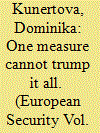

|
|
|
|
|
| Summary/Abstract |
This paper calls for a qualitative turn in discussing NATO burden-sharing. The paper takes issue with the numerical burden-sharing narrative in NATO and identifies its two main problems. Despite being simple, the 2% defence spending pledge lacks other basic attributes of any contributory system: fairness and effectiveness. Drawing from concepts of distributive justice, the paper analyses NATO’s first burden-sharing debates and demonstrates that due to their qualitatively different capabilities, the allies agreed on an egalitarian ability-to-pay distributive justice. Furthermore, it shows that the allies refrained from implementing fairness in terms of a one-size-fits-all formula, since this simple numerical approach could not produce fair and effective burden-sharing at the same time. Rather, they developed a dynamic framework for optimal sharing. These formative burden-sharing debates provide valuable lessons learned for the current build-up of NATO’s posture: less focused on formal sharing, more concerned with strategic outputs.
|
|
|
|
|
|
|
|
|
|
|
|
|
|
|
|
| 12 |
ID:
158957
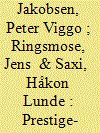

|
|
|
|
|
| Summary/Abstract |
In this article we broaden the conventional understanding of prestige and show that prestige-seeking played a major role in the Danish and Norwegian decisions to provide military support to post-Cold War US-led wars. Both countries made costly military contributions in the hope of increasing their standing and prestige in Washington. Both governments regarded prestige as a form of soft power, which they could later convert into access, influence, and US support. Our findings are far from trivial. They make a theoretical contribution by demonstrating that small powers understand and seek prestige in ways that differ fundamentally from the ways great powers do. They also help to explain why smaller US allies made costly contributions to the Balkan, Afghan, Iraq, and Libyan wars at a time when there was no direct threat to their national security and their security dependence on the United States was low. The high value that small US allies attach to their visibility and prestige in Washington suggests that it is far easier for the United States to obtain military support from smaller allies than Realist studies of burden-sharing and collective action problems would lead us to expect.
|
|
|
|
|
|
|
|
|
|
|
|
|
|
|
|
| 13 |
ID:
069859
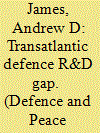

|
|
|
| 14 |
ID:
166609
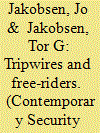

|
|
|
|
|
| Summary/Abstract |
This article investigates the relationship between U.S. overseas troops and the willingness of the citizens of host states to fight for their country. The study joins the long-running debate about burden-sharing and free-riding among U.S. allies. Unlike most previous empirical studies, we focus on non-material or intangible measures of the underlying concepts. Our dependent variable estimates the proportion of citizens expressing a willingness to fight for their country. Scores at the aggregate-national as well as the individual level are shaped by the presence of U.S. military forces, which act as a “tripwire” signaling credible security commitments. This increases opportunities of (non-material) free-riding. We present both bivariate and multivariate analyses covering the period 1981–2014 to test this supposition. Findings indicate that once U.S. troop levels reach a certain threshold (between 100 and 500 troops), citizens’ willingness to fight drops significantly. This likely reflects non-material free-riding.
|
|
|
|
|
|
|
|
|
|
|
|
|
|
|
|
| 15 |
ID:
182681
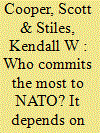

|
|
|
|
|
| Summary/Abstract |
Studies of NATO rely heavily on military spending as a fraction of GDP as the key indicator of members’ contribution to the alliance, but a growing number of scholars have challenged this approach. We suggest that each member’s public goods provision is a better measure of commitment to the alliance. In the case of post-Cold War NATO, out-of-area troop deployments (adjusted for population) constitute one of the strongest indicators of a state’s contribution to public goods. Providing troops for NATO missions in Afghanistan, Kosovo, and Bosnia-Herzegovina is one of the clearest signals of high commitment to the alliance. Using deployment data from 2004 to 2018, we show that there is evidence of disproportionate burden-sharing within the alliance. Countries like Slovenia, Denmark, the USA and UK contributed far more to NATO deployments than others like Turkey, Spain, Poland, and Portugal. We also use the data to begin examining possible causes of these disparities. We find that wealthier countries, countries that spend more on their militaries, and newer alliance members are more likely to contribute. Our indicator and first-cut model open avenues for further research on why some members demonstrate higher commitment to NATO than others.
|
|
|
|
|
|
|
|
|
|
|
|
|
|
|
|
|
|
|
|
|